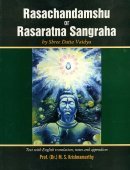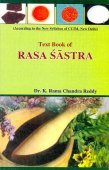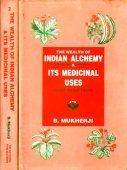Rasaka, Rāsaka: 16 definitions
Introduction:
Rasaka means something in Hinduism, Sanskrit, Jainism, Prakrit, Buddhism, Pali. If you want to know the exact meaning, history, etymology or English translation of this term then check out the descriptions on this page. Add your comment or reference to a book if you want to contribute to this summary article.
In Hinduism
Ayurveda (science of life)
Rasashastra (Alchemy and Herbo-Mineral preparations)
Source: Wisdom Library: Rasa-śāstra1) Rasaka (रसक, “Calamine” or “Zinc ore”):—Sanskrit technical term used in Rasaśāstra literature (Medicinal Alchemy) such as the Rasaprakāśasudhākara or the Rasaratna-samuccaya. Rasaka is an ingredient which can be used in combinations with Rasa (mercury) in various recipes.
2) Rasaka (रसक, “zine blend, zinc ores”):—One of the eight mahārasa (‘superior minerals’), according to the Rasaprakāśasudhākara: a 13th century Sanskrit book on Indian alchemy, or, Rasaśāstra. It is also known as Kharpara.
Rasaka has the following two varieties:
- Kāravellaka (used for satvapātana purpose)
- and Dardura (used for preparing medicines).
Rasaka refers to “calamine”. (see Bhudeb Mookerji and his Rasajalanidhi)
Source: Indian Journal of History of Science: Rasaprakāśa-sudhākara, chapter 4-5Rasaka is of two types, viz: 1. Kāravellaka; and 2. Dardura. Nāgārjuna, the father of Indian alchemy (rasavāda), had claimed that Sūta (mercury) and Kharpara/Rasaka (zinc ore) both if made agnisaha (thermostable) then these are considered as the best of all Rasas (mahārasas) and those who have succeeded in this, for them it is easy to achieve svarṇa-mayī-siddhi (gold making knowledge). There is no doubt in it. It means in rasavāda (alchemy) Rasa (mercury) and Rasaka (zinc ores) are the most important drugs to achieve success in gold making.

Āyurveda (आयुर्वेद, ayurveda) is a branch of Indian science dealing with medicine, herbalism, taxology, anatomy, surgery, alchemy and related topics. Traditional practice of Āyurveda in ancient India dates back to at least the first millenium BC. Literature is commonly written in Sanskrit using various poetic metres.
Chandas (prosody, study of Sanskrit metres)
Source: Journal of the University of Bombay Volume V: Apabhramsa metres (2)Rāsaka (रासक) is the name of a catuṣpadi metre (as popularly employed by the Apabhraṃśa bards), as discussed in books such as the Chandonuśāsana, Kavidarpaṇa, Vṛttajātisamuccaya and Svayambhūchandas.—Rāsaka has 21 mātrās in each of their four lines, divided into groups of 18, 3 (III) mātras with the yati after the 14th mātrā.—Both Hemacandra and Kavidarpaṇa II.23, mention a 2nd variety of the Rāsaka which contains 23 mātrās in its line, formed by 5 caturmātras followed by a short and a long letter at the end. In fact, Rāsaka is a common name for all kinds of the mātrā-vṛttas (Jātis), like the names Galitaka and Khañjaka.

Chandas (छन्दस्) refers to Sanskrit prosody and represents one of the six Vedangas (auxiliary disciplines belonging to the study of the Vedas). The science of prosody (chandas-shastra) focusses on the study of the poetic meters such as the commonly known twenty-six metres mentioned by Pingalas.
In Jainism
General definition (in Jainism)
Source: archive.org: TrisastisalakapurusacaritraRāsaka (रासक) refers to a “kind of song”, according to chapter 2.2 [ajitanātha-caritra] of Hemacandra’s 11th century Triṣaṣṭiśalākāpuruṣacaritra: an ancient Sanskrit epic poem narrating the history and legends of sixty-three illustrious persons in Jainism.—M.C. defines rasa as “a sort of song in the Hindoostanee language”. Rāsaka is also used for the circular dance itself.
Accordingly: “[...] Among these Indras and gods some, burdened with a load of devotion, lifted the full pitchers and brought them to the bathers. [...] Some shook Mt. Mandara by stamping their feet; others split the earth by blows with their hands. Some made a repeated outcry with great joy; others sang rāsakas, moving in a circle. Some blazed artificially; others cried for amusement; some thundered deeply; and others flashed like lightning”.

Jainism is an Indian religion of Dharma whose doctrine revolves around harmlessness (ahimsa) towards every living being. The two major branches (Digambara and Svetambara) of Jainism stimulate self-control (or, shramana, ‘self-reliance’) and spiritual development through a path of peace for the soul to progess to the ultimate goal.
Languages of India and abroad
Pali-English dictionary
Source: BuddhaSasana: Concise Pali-English Dictionaryrasaka : (m.) a cook.
Source: Sutta: The Pali Text Society's Pali-English DictionaryRasaka, (fr. rasa, cp. Classic Sk. rasaka) a cook J. V, 460, 461, 507. (Page 567)

Pali is the language of the Tipiṭaka, which is the sacred canon of Theravāda Buddhism and contains much of the Buddha’s speech. Closeley related to Sanskrit, both languages are used interchangeably between religions.
Sanskrit dictionary
Source: DDSA: The practical Sanskrit-English dictionaryRasaka (रसक).—Soup made from meat.
Derivable forms: rasakam (रसकम्).
--- OR ---
Rāsaka (रासक).—A kind of minor drama; see S. D.548.
Derivable forms: rāsakam (रासकम्).
Source: Cologne Digital Sanskrit Dictionaries: Edgerton Buddhist Hybrid Sanskrit DictionaryRasaka (रसक).—(m. or nt.), some sort of gem: anye (devā) rasakehi samalaṃkṛtaṃ (bodhivṛkṣaṃ saṃjānanti) Mahāvastu ii.311.3 (in a list including various jewels etc.).
Source: Cologne Digital Sanskrit Dictionaries: Shabda-Sagara Sanskrit-English DictionaryRasaka (रसक).—m.
(-kaḥ) Stewed or boiled meat. E. rasa juice, aff. kan .
--- OR ---
Rāsaka (रासक).—n.
(-kaṃ) A kind of minor drama in one act.
Source: Cologne Digital Sanskrit Dictionaries: Benfey Sanskrit-English DictionaryRasaka (रसक).—[rasa + ka], m. Stewed or boiled meat.
Source: Cologne Digital Sanskrit Dictionaries: Monier-Williams Sanskrit-English Dictionary1) Rasaka (रसक):—[from ras] m. or n. soup made from meat, [Kathāsaritsāgara]
2) Rāsaka (रासक):—[from rās] m. a kind of dance, [Harṣacarita]
3) [v.s. ...] a kind of song, [ib.]
4) [v.s. ...] (in music) a kind of measure, [Saṃgīta-sārasaṃgraha]
5) [v.s. ...] mn. a kind of dramatic entertainment, [Sāhitya-darpaṇa]
Source: Cologne Digital Sanskrit Dictionaries: Yates Sanskrit-English Dictionary1) Rasaka (रसक):—(kaḥ) 1. m. Boiled meat.
2) Rāsaka (रासक):—(kaṃ) 1. n. A kind of drama.
[Sanskrit to German]
Sanskrit, also spelled संस्कृतम् (saṃskṛtam), is an ancient language of India commonly seen as the grandmother of the Indo-European language family (even English!). Closely allied with Prakrit and Pali, Sanskrit is more exhaustive in both grammar and terms and has the most extensive collection of literature in the world, greatly surpassing its sister-languages Greek and Latin.
Kannada-English dictionary
Source: Alar: Kannada-English corpusRāsaka (ರಾಸಕ):—[noun] (rhet.) a variety of plays with a single act having a shrewd heroine and a stupid or foolish hero.
Kannada is a Dravidian language (as opposed to the Indo-European language family) mainly spoken in the southwestern region of India.
See also (Relevant definitions)
Starts with (+15): Rasaka-rasa, Rasakadambakallolini, Rasakala, Rasakali, Rasakalika, Rasakalpa, Rasakalpadruma, Rasakalpalata, Rasakalpana, Rasakalpasarastava, Rasakalpasaratattva, Rasakalyanini, Rasakalyaninivrata, Rasakalyanivrata, Rasakanem, Rasakankali, Rasakapura, Rasakara, Rasakaradana, Rasakarma.
Ends with (+9): Angirasaka, Anugrasaka, Ardrashaka, Bhadrashaka, Bharasaka, Bhayarasaka, Dushtatrasaka, Gaurashaka, Grasaka, Hrasaka, Kharashaka, Kharparirasaka, Kshirashaka, Makaracaka, Mugarasaka, Natyarasaka, Nirashaka, Patrashaka, Pattrashaka, Pharasaka.
Full-text: Menakahita, Natyarasaka, Trirasaka, Trisaraka, Kharparirasaka, Uparupaka, Kharpara, Karavellaka, Ishvarasuri, Amadevasuri, Ishvara, Amadeva, Maharasa, Dardura, Shantisuri, Shanti, Canda, Rasa.
Relevant text
Search found 14 books and stories containing Rasaka, Rāsaka; (plurals include: Rasakas, Rāsakas). You can also click to the full overview containing English textual excerpts. Below are direct links for the most relevant articles:
Hanuman Nataka (critical study) (by Nurima Yeasmin)
Part 2: Varieties of Dṛśyakāvya < [Chapter 1]
Malatimadhava (study) (by Jintu Moni Dutta)
Part 2a - Mālatīmādhava as a Prakaraṇa < [Chapter 1 - Introduction]
Rasa Jala Nidhi, vol 2: Minerals (uparasa) (by Bhudeb Mookerjee)
Part 5 - Extraction of essence from Rasaka (calamine) < [Chapter VII - Uparasa (8): Rasaka or Kharpara (calamine)]
Part 3 - Purification of kharpara < [Chapter VII - Uparasa (8): Rasaka or Kharpara (calamine)]
Part 1 - Characteristics of Rasaka/Kharpara (calamine) < [Chapter VII - Uparasa (8): Rasaka or Kharpara (calamine)]
Gati in Theory and Practice (by Dr. Sujatha Mohan)
Importance of Gati in Uparūpakas < [Chapter 3 - Application of gati in Dṛśya-kāvyas]
Performance of Gati through Maṇḍalas < [Chapter 2 - Concept and technique of Gati]
Observations in Post-Bharata works < [Chapter 5 - Conclusion]
Rasa Jala Nidhi, vol 3: Metals, Gems and other substances (by Bhudeb Mookerjee)
Part 1 - Characteristics of Zinc (yasoda) < [Chapter V - Metals (5): Yasoda (zinc)]
Rasa Jala Nidhi, vol 1: Initiation, Mercury and Laboratory (by Bhudeb Mookerjee)
Part 3 - Drawing of a hexagonal lotus diagram < [Chapter II - Initiation of Disciple]
Part 16 - Mercurial operations (14): Exhaustion of mercury (yarana) < [Chapter IV-V - Mercurial operations]
Part 1 - Additional process for transformation of base metals into gold and silver < [Chapter VIII - Conclusion of first volume]
Related products


